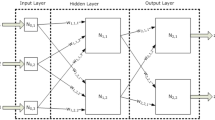Abstract
More and more enterprises hope to achieve cooperation and win–win. However, many companies often have problems such as insufficient partner credit, which seriously affects the quality of cooperation. In order to effectively evaluate the credit, this paper constructs a personal credit evaluation model. The model compares the weight adjustment method with BP neural network and other methods. Compared with the BP neural network weight adjustment algorithm, the improved algorithm has obvious advantages in accuracy and convergence speed. The simulation results show that the green supply chain cooperation credit evaluation model can better evaluate the environmental behavior of enterprises. The BP neural network can better solve the problem of slow convergence and premature convergence, and can search data more accurately. The algorithm has good robustness. The evaluation model has high optimization accuracy, which shows that BP neural network can better learn and evaluate the credit of green supply chain at different levels.







Similar content being viewed by others
References
Bakeshlou EA, Khamseh AA, Asl MAG, Sadeghi J, Abbaszadeh M (2017) Evaluating a green supplier selection problem using a hybrid MODM algorithm. J Intell Manuf 28(4):913–927
Sinha N, Garg AK, Dhingra S, Dhall N (2016) Mapping the linkage between organizational culture and TQM. Benchmarking 23(1):208–235
Min H, Min H, Joo SJ, Kim J (2017) A data envelopment analysis for establishing the financial benchmark of korean hotels. Int J Serv Oper Manag 4(2):201
Herath D, Mckenzie D, Pathak Y, De Mel S (2015) Radio frequency (un)identification: results from a proof-of-concept trial of the use of RFID technology to measure microenterprise turnover in sri lanka (english). Dev Eng 1(C):4–11
Wei G, Basu M, Zhang C, Wei L (2017) A unified framework for credit evaluation for internet finance companies: multi-criteria analysis through AHP and DEA. Int J Inf Technol Decis Mak 3(3):597–624
Bing W, Han S, Jin X, Hu X, Fan J (2016) Error compensation based on BP neural network for airborne laser ranging. Optik Int J Light Electron Opt 127(8):4083–4088
Liu T, Yin S (2017) An improved particle swarm optimization algorithm used for BP neural network and multimedia course-ware evaluation. Multimed Tools Appl 76(9):11961–11974
Zhang RC, Yang K, Wu QY, Yang JH (2017) Research on low-voltage arc fault detection based on BP neural network. J Sichuan Univ 651–653(1):499–502
Zhang J, Yang YP, Zhang JM (2016) A mec-BP-adaboost neural network-based color correction algorithm for color image acquisition equipments. Optik Int J Light Electron Opt 127(2):776–780
Ma C, Zhao L, Mei X, Yang J (2017) Thermal error compensation of high-speed spindle system based on a modified BP neural network. Int J Adv Manuf Technol 89(9–12):1–15
Acknowledgements
This work was supported by the Major Program of National Social Science Foundation of China (19ZDA082).
Author information
Authors and Affiliations
Corresponding author
Ethics declarations
Conflict of interest
Conflict of interest the authors declare that they have no conflict of interest.
Additional information
Publisher's Note
Springer Nature remains neutral with regard to jurisdictional claims in published maps and institutional affiliations.
Rights and permissions
About this article
Cite this article
Chen, J., Huang, S. Evaluation model of green supply chain cooperation credit based on BP neural network. Neural Comput & Applic 33, 1007–1015 (2021). https://doi.org/10.1007/s00521-020-05420-6
Received:
Accepted:
Published:
Issue Date:
DOI: https://doi.org/10.1007/s00521-020-05420-6




